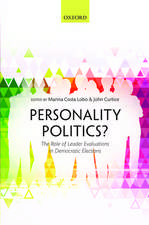A Unified Theory of Voting: Directional and Proximity Spatial Models
Autor Samuel Merrill, III, Bernard Grofmanen Limba Engleză Paperback – 12 sep 1999
| Toate formatele și edițiile | Preț | Express |
|---|---|---|
| Paperback (1) | 232.95 lei 43-57 zile | |
| Cambridge University Press – 12 sep 1999 | 232.95 lei 43-57 zile | |
| Hardback (1) | 552.10 lei 43-57 zile | |
| Cambridge University Press – 12 sep 1999 | 552.10 lei 43-57 zile |
Preț: 232.95 lei
Nou
Puncte Express: 349
Preț estimativ în valută:
44.58€ • 46.28$ • 37.17£
44.58€ • 46.28$ • 37.17£
Carte tipărită la comandă
Livrare economică 24 martie-07 aprilie
Preluare comenzi: 021 569.72.76
Specificații
ISBN-13: 9780521665490
ISBN-10: 0521665493
Pagini: 230
Ilustrații: 33 b/w illus. 40 tables
Dimensiuni: 152 x 228 x 17 mm
Greutate: 0.32 kg
Editura: Cambridge University Press
Colecția Cambridge University Press
Locul publicării:New York, United States
ISBN-10: 0521665493
Pagini: 230
Ilustrații: 33 b/w illus. 40 tables
Dimensiuni: 152 x 228 x 17 mm
Greutate: 0.32 kg
Editura: Cambridge University Press
Colecția Cambridge University Press
Locul publicării:New York, United States
Cuprins
1. Introduction; Part I. Models of Voter Behavior: 2. Alternative models of issue voting; 3. A unified model of issue voting: proximity, direction, and intensity; 4. Comparing the empirical fit of the directional and proximity models for voter utility functions; 5. Empirical model fitting using the unified model: voter utility; 6. Empirical fitting of probabilistic models of voter choice in two-party electorates; 7. Empirical fitting of probabilistic models of voter choice in multiparty electorates; Part II. Models of Party or Candidate Behavior and Strategy: 8. Equilibrium strategies for two-candidate directional spatial models; 9. Long-term dynamics of voter choice and party strategy; 10. Strategy and equilibrium in multicandidate elections; 11. Strategy under alternative multicandidate voting procedures.
Recenzii
'… the most significant contribution of this book is that it successfully derives explanations for macroscopic phenomenon, such as the nature of party system and government alternations, based on the proximity, directional and mixed models of micro-level voting behaviour.' Japanese Journal of Political Science
Descriere
The authors develop a unified model that incorporates voter motivations and assess its empirical predictions in the US, Norway, and France.











